Treatment of PASTA tears in throwing athletes focuses on avoiding stiffness, failed repairs
This article is the second in a two-part series on surgical techniques for partial thickness rotator cuff tears. Part 1, which was published in the June issue of Orthopedics Today, covered the partial articular-sided supraspinatus tendon avulsion (PASTA) surgical repair performed on non-throwers. This article covers the repair strategy, rationale and surgical technique used in throwing athletes.
Overhead throwing athletes, and especially baseball pitchers, subject their shoulders to extreme repetitive forces and have rotator cuff injury mechanisms that differ from other athletes. The partial thickness rotator cuff tear (PTRCT) is now recognized as a common source of pain that limits an athlete’s ability to throw. It is believed that repetitive throwing creates eccentric tensile stress in the rotator cuff tendon. In addition, internal impingement of the rotator cuff on the posterior superior glenoid and labrum in the late cocking position of throwing can cause direct injury to the undersurface of the rotator cuff. Anterior instability and posteroinferior capsule contracture can further escalate the pathologic internal impingement process.
Most likely, different combinations of these features contribute to rotator cuff injury in individual patients. It must also be emphasized that most throwing athletes have developed anatomic adaptations for their ability to throw and that, to a certain extent, internal impingement is considered a normal and required feature of throwing.
Assess pathology
It is important to recognize that most overhead throwing athletes have a spectrum of pathology that combine with PTRCTs, which often includes posterior superior labral injury. Appropriate recognition and management of each component is critical to restoring the ability to throw without symptoms. MRI is used to assess pathology and must be correlated to the athlete’s symptoms since there is a high incidence of PTRCTs in asymptomatic throwers and the magnitude of rotator cuff pathology often does not correlate well with symptoms. Surgery is indicated when nonoperative treatment has failed and specific surgical treatment includes debridement of the tear or its repair. Significant mechanical dysfunction, seasonal timing, physical and imaging findings, and patient demands all influence surgical indications.
Debridement of poor quality torn tissue is recommended for lesions sized less than 25% of the tendon thickness. For lesions sized between 25% and 75% of the tendon thickness, debridement of the tear edges and assessment for a delaminated component is performed. If a delaminated tear is identified, then an intratendinous repair is done. For tears constituting more than 75% of tendon thickness, the intact tendon quality should be scrutinized. In rare situations and when extensive tendinosis is identified, the tendon may be incised to create a full thickness tear. Occasionally, partial tears are repaired back to the bone with suture anchors when there is minimal retraction, and the tear and its location are in an anterior position on the greater tuberosity. The intent is that the repair does not over tension the rotator cuff or obstruct normal internal impingement contact in the cocking phase of throwing.
The altered anatomy and soft tissue demands specific to throwing athletes are chief considerations in their repair strategies. In addition, any shoulder stiffness postoperatively can have a major effect on a pitcher’s performance postoperatively and must be avoided. The normal footprint of the supraspinatus insertion ranges from about 12 mm to 14 mm in the medial-lateral direction. In high level throwers, rotator cuff footprint contact on the glenoid from internal impingement is expected and therefore repair into those insertional regions may cause stiffness or failure of the repair. Therefore, tears with intralaminar extension, which is a common feature in throwers, are treated with intratendinous repair without repair directly to the tuberosity.
Surgical technique
The patient is placed in the lateral decubitus position with either general or regional anesthesia. An examination under anesthesia is done to assess laxity in the anterior, posterior and inferior directions. Portals are created that include a standard posterior viewing portal, an anterior working portal, and a lateral working portal. The anterior working portal is positioned more superior and lateral than is typically done, which helps to better access the undersurface of the rotator cuff with working instruments, such as shavers and graspers.
The camera is placed into the joint through the posterior portal and a diagnostic exam is performed prior to creating additional portals. Understanding and appreciating the complete pathology may influence exact portal placement. Particular attention is given to the superior, posterior and anterior labrum, and the capsule.
Evaluation of the undersurface of the rotator cuff is then carried out by the surgeon. The arm is abducted and adducted, and internally and externally rotated as needed to fully appreciate the tear. Special attention should be given to the undersurface of the rotator cuff at the junction between the supraspinatus and infraspinatus tendons, which is the typical site for damage in throwers.
Simple debridement possible
A small shaver is used to resect frayed edges of the damaged rotator cuff (Figures 1 and 2). A grasper is used to fully assess the presence of a delaminated flap. The percent of the rotator cuff tear can then be estimated. A simple technique is to use the known diameter of the shaver or a probe to measure the exposed footprint. An assumption can be made that the tendon thickness is 12 mm to 14 mm in the medial-lateral direction, and this can allow a percent calculation to be made. If no delaminated flap is encountered, simple debridement may be all that is required for treating the rotator cuff.
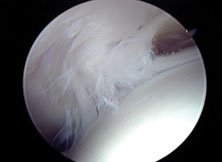
Figure 1. A partial thickness undersurface tear of the posterior aspect of the supraspinatus tendon is shown.
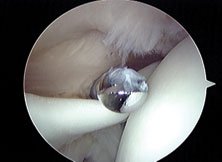
Figure 2. From the anterior portal the surgeon uses a shaver to debride a partial thickness rotator cuff tear.
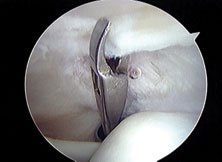
Figure 3. The tear is grasped to determine the mobility of the intralaminar component of the tear component.
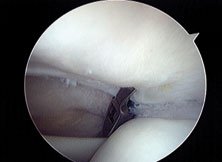
Figure 4. The anatomic repair site is shown.
Images: Center for Shoulder, Elbow and Sports Medicine at Columbia University Medical Center
If a delaminated tear is encountered, the tissue quality, magnitude and mobility of the lamination are appreciated using a soft tissue grasper introduced from the anterior portal (Figures 3 and 4). The inside of the lamination is abraded with a shaver or rasp to enhance healing. Before any passing of sutures, the subacromial space is inspected and a complete bursectomy is performed so that the sutures can be easily found later in the procedure. Mattress sutures are then placed from outside to inside using a spinal needle.
A spinal needle is placed percutaneously just lateral to the acromion and it penetrates the intact bursal lamina. The needle is maneuvered to penetrate the articular lamina at the desired location (Figure 5). A soft tissue grasper can hold the articular lamina reduced if necessary.
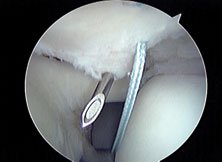
Figure 5. A spinal needle is placed through both laminations of the tear to assist with suture passing.
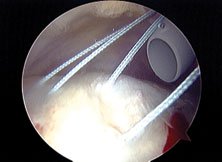
Figure 6. The sutures are identified.
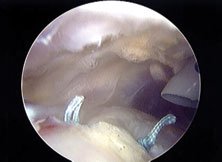
Figure 7. The sutures are tied in the subacromial space from the lateral working portal.
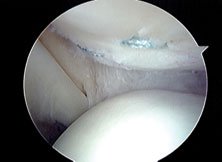
Figure 8. Final repair of the tear is shown as visualized from the glenohumeral joint.
Mattress suturing
A monofilament suture is passed through the needle and retrieved out the anterior cannula. The suture is shuttled by tying the monofilament suture to a #2 nonabsorbable braided suture outside the cannula. Another monofilament suture is passed across the rotator cuff tear and retrieved out the anterior cannula with the braided suture. The braided suture is then shuttled through the rotator cuff to create a mattress suture. These steps are repeated to create the necessary number of mattress sutures to fix the tear.
The camera is then placed in the subacromial space and the sutures are tied through a standard lateral working portal (Figures 6 and 7). The camera is then placed back in the glenohumeral joint and the repair is evaluated (Figure 8).
Rotator cuff tears are highly prevalent in throwing athletes and can now be easily diagnosed. Challenges remain, however, in determining why some tears become symptomatic and in more precisely defining the indications for surgery. Lastly, treatment guidelines for surgical strategy have been established, but longer term follow-up is required to determine their effectiveness.
For more information:
- Christopher S. Ahmad, MD, can be reached at Center for Shoulder, Elbow, and Sports Medicine, Department of Orthopaedic Surgery, Columbia University, 622 W. 168th St., PH-11-Center, New York, NY 10032; email: csa4@columbia.edu.
Disclosure:
- Ahmad is a paid consultant for Arthrex Inc.
